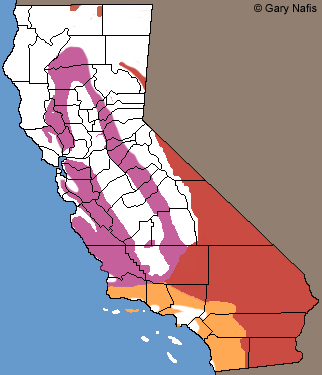Nightsnakes found in California


Not Dangerous (Non-poisonous) NIghtsnakes do not have venom that is dangerous to most humans. |
||
This small nocturnal snake is typically found on roads at night, or while hiding underneath surface objects during daytime. It can be found in many habitats; deserts, grasslands, mountains, chaparral, sagebrush. Two species are present in California, with one consisting of two subspecies. |
||
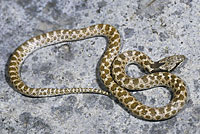 |
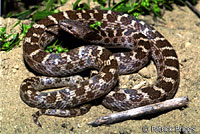 |
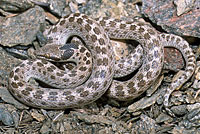 |
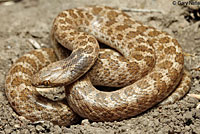 |
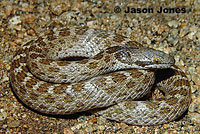 |
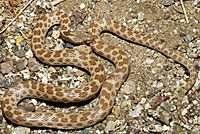 |
| California Nightsnake Hypsiglena ochrorhyncha nuchalata |
San Diego Nightsnake Hypsiglena ochrorhyncha klauberi |
Desert Nightsnake Hypsiglena chlorophaea deserticola |
Nightsnakes vs. Similar Species |
||
The best way to differentiate a nightsnake from other small snakes with a blotched pattern found in the same area is to look at the pupils and, if necessary, the pattern on the head. Nightsnakes have vertical pupils while most other similar snakes have round pupils. |
||
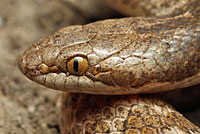 |
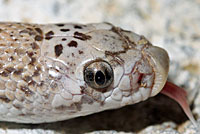 |
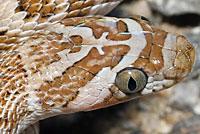 |
| Nightsnakes - pupils are vertical | Spotted Leaf-nosed Snake - pupils are vertical, but the lack of dark head markings and the large scale on the nose will identify this species. | Lyresnakes - pupils are vertical, but the distinct pattern on the head will identify this species. |
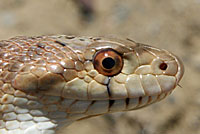 |
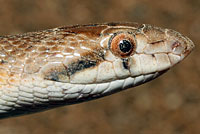 |
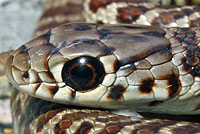 |
| Gophersnakes - pupils are round | Glossy Snakes - pupils are round | Juvenile Western Yellow-bellied Racer - pupils are round |
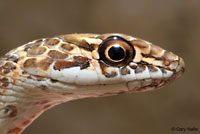 |
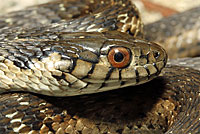 |
|
| Red Racer/Coachwhip - pupils are round | Gartersnakes - pupils are round | |
Identifying the three types of Nightsnakes found in California |
||
There is not much overlap in the distribution of the three forms of nightsnakes found in California, so the best way to identify a species or subspecies of nightsnake is by looking at where it was found on the range map below. |
||
| Range Map Purple : Hypsiglena torquata nuchalata - California Nightsnake Red: Hypsiglena torquata deserticola - Desert Nightsnake Orange: Hypsiglena ochrorhyncha klauberi - San Diego Nightsnake |
||
H. o. nuchalata vs. H. o. klauberi |
||
In areas where these two subspecies come into contact, you may be able to identify them by looking at the side of the head and observing whether or not the dark stripe behind the eye contacts the dark collar on the nape of the neck (the nuchal collar) although there appear to be some snakes that don't follow the rule exactly. |
||
 |
||
| The stripe behind the eye of H. o. nuchalata usually contacts the nuchal collar. | ||
 |
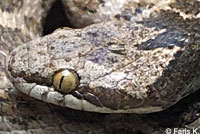 |
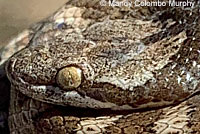 |
| H. o. nuchalata | H. o. nuchalata |
H. o. nuchalata |
| The stripe behind the eye of H. o. klauberi usually does not contact the nuchal collar. | ||
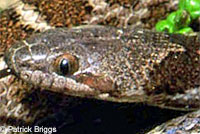 |
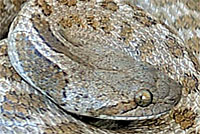 |
 |
| H. o. klauberi | H. o. klauberi | H. o. klauberi |
H. c. deserticola vs. H. o. klauberi |
||
The stripe behind the eye of H. chlorophea deserticola also usually contacts the nuchal collar. This can be helpful with identification in areas where H. c. deserticola it comes in to contact with H. ochroryncha klauberi, whose eye stripe usually does not contact the nuchal collar (see illustrations above.) |
||
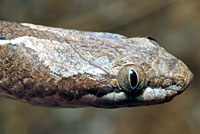 |
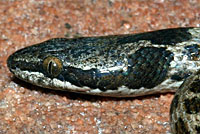 |
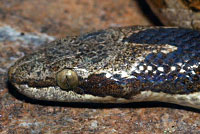 |
| H. c. deserticola | H. c. deserticola | H. c. deserticola |
H. chlorophaea vs. H. ochroryncha |
||
The best way to differentiate these species is by range or DNA data. Some sources show that H. chloophaea deserticola has scales in 21 rows and that H. ochroryncha has scales in 19 rows, but it's not clear how definitive this scale count is. |
||
Return to the Top
© 2000 -

